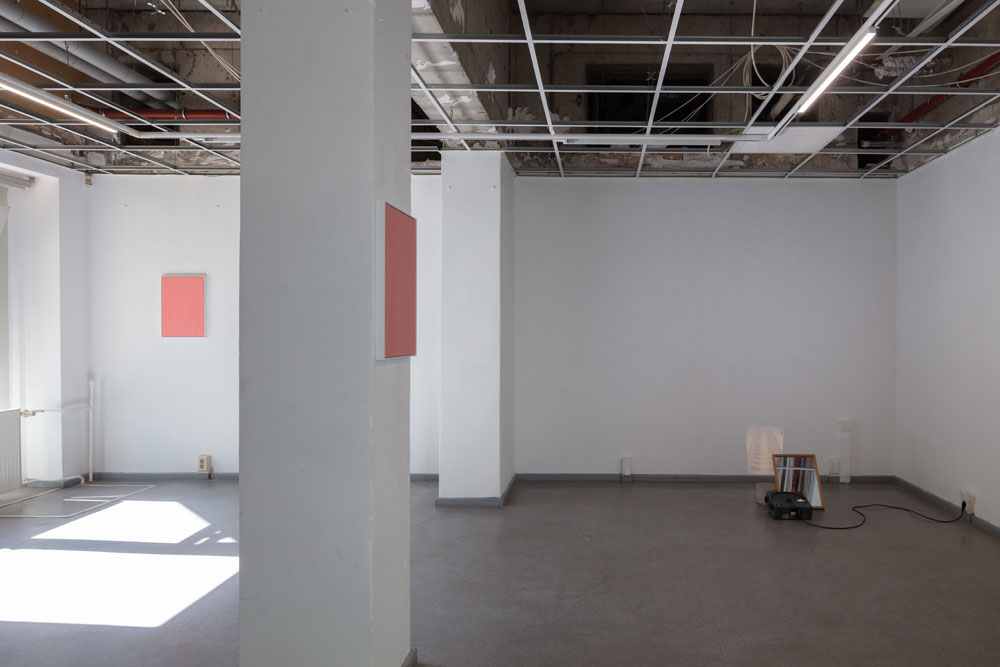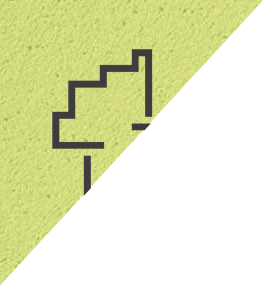Heike Baranowsky,
Veronika Kellndorfer
und Mirjam Thomann
Wand an Wand an Wand
exhibition from September 1 to January 13, 2021
In the exhibition “Wand an Wand an Wand (Wall to Wall to Wall),” artists Heike Baranowsky, Veronika Kellndorfer, and Mirjam Thomann work with the specific exhibition situation in the ‘Studio im Hochhaus,’ which is housed in the former offices of the ‘Volkssolidarität’, the organisation for senior citizens’ welfare. The particular historical, architectural and socio-political features of this location – a ground-floor gallery in a high-rise complex built in the late 1980s where 50,000 people still live today – serve as the starting point for the works shown in this exhibition. These works are placed in relation to the site itself and to each other by means of a collectively implemented spatial intervention – the removal of the ceiling panels. The revealed aluminium grid, the pipes and cables, and the concrete skeleton of the ceiling all create the impression of an archaeological dig; however, the difference is that instead of excavating new layers of soil, an unhindered view of unexpected heights is revealed here.
Veronika Kellndorfer deals with this reversal of the usual directed perception in her works that were conceived specifically for this exhibition. She projects an image of the 20-storey building as a small-format slide, in miniature size, onto a wall just above the skirting. A two-way mirror reflects the grid-patterned façade of the building in the form of a multiple refracted projection through the grid structure and onto the ceiling structure. The perspective in this slide, which allows us to appreciate the height of the building, is underscored by our view of the ceiling: the exterior is connected to this ground-floor space – a projection of the location onto itself.
In Kellndorfer’s second work, Interior, Corner, a slide projector beames onto a number of objects. A sculpture consists of a constructivist arrangement of simple – geometrical figures – made from dichroic and screen-printed glass, together with a wooden pedestal. Beside this, there is a stone block that supports a spotlight and a plant that Kellndorfer borrowed from Heike Baranowsky for the duration of the exhibition. The interaction of the light source with the glass objects and the plant creates a cinematic combination of complementary color effects, shadows and projections. Monstera deliciosa, is a reference to the jungle-like atrium of Lina Bo Bardi’s ‘Casa de Vidro’ in São Paulo, the screen printed image in the center of the sculpture. Synonymous with bourgeois interiors thus creates a link between an East German housing project in the outskirts of Berlin and Bo Bardi’s tropical modernism.
182 ½ consists of camera obscura shots of the course of the sun from its highest to its lowest position over a period of six months. The photographs by Heike Baranowsky are on display in the rear exhibition room. The cameras were positioned at various locations that have a personal significance for the artist, such as her home, her work place and her studio. The cameras used a large-format b/w negative film sheet that recorded the course of the sun’s light from east to west in the form of parabola-shaped paths. The highest zenith indicates the summer solstice, while the lowest zenith exposes the winter solstice. As well as showing the sun’s path, these architectural-like patterns also reveal information about weather conditions. Long exposures compress a period of time into a single moment, just as if an entire film was reduced to a single image. Nevertheless, the temporal aspect and, in particular, its overall duration can still be discerned.
The Snake Plant or African Spear (Sansevieria cylindrica) is positioned on a pedestal made of ceiling panels that the three artists removed. In this way, the plant can show off its arcing forms, and the stack of panels and the plant itself both become (living) sculptures. The conceptual approach in Baranowsky’s work lies in changes of perspective: the position of the silent observer of phenomena does not exclude the activity of shaping visual realities.
Mirjam Thomann is showing two works that she positions at the peripheries of the exhibition room, at the entrances, transitions and exits of the space. The text that appears on a window pane, mirror-inverted from the inside and legible from the outside, was inspired by the poster “I AM THE DOOR” by artist Milena Muzquiz, which Thomann saw in the living room of a mutual friend while visiting Los Angeles in 2019. The phrase used by Muzquiz is taken from words spoken by Jesus Christ, while the slightly modified version “I AM A DOOR” directly refers to the architectural characteristics of the exhibition space: the transparent threshold between the inside and outside, the visitors and passers-by reflected in this phrase, the paradoxical situation of being included or excluded and simultaneously totally visible, and the transformative potential of doors.
The three drawings in the first exhibition room are part of a series that was created using the “Light Flesh,” “Medium Flesh,” and “Dark Flesh” pencils produced by Faber Castell. So-called “flesh colours”, which make reference to the bodily and the living, are used in various materials and forms in Thomann’s works and, in this particular case, reflect the movement of the bodies in the space.
All pictures: Thomas Bruns






